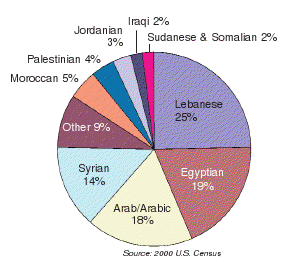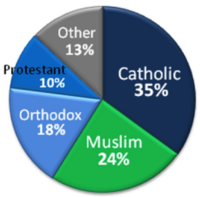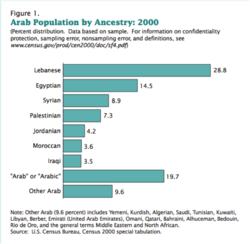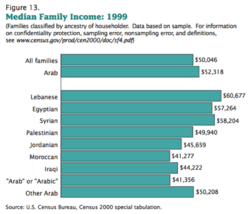From The Peopling of New York City
Contents |
Videos
Arab American's in New York Introduction from Joshua Pulinat on Vimeo.
Arab American Assimilation in New York from Joshua Pulinat on Vimeo.
Demographics
Consistent with its reputation as a “melting pot,” New York's Arab American population, which ranks third among the states, is diversified by geography, generation and national origin. New York is typically regarded as the “mother colony” for the initial wave of Arabic-speaking immigrants; it is still a major gateway destination for new immigrants. Metropolitan New York City is home to a diverse Arab community, which has grown to become quite an influential power within the area.
When walking around New York City, one can see the many Arab businesses established from block to block. Arabs that
reside New York City come from a wide array of countries. The majority of the Arab populations residing within NYC come from Lebanon or Egypt. [2] Today, approximately 160,000 New Yorkers can trace their origins back to the Arabic-speaking countries of the Middle East and North Africa. [3] The Arab American population embodies more than a dozen nationalities, which reinforces the idea that New York City is, to this day, one of the biggest cultural ‘melting pots’ in the world.
Religion
Religion greatly shapes an individual. Arab immigrants residing with the United States come from a spectrum of religions, and it is this variety that allows each and every single one of them to hold on their own individuality. Religion is an important factor in deterring the Arab American identity. It greatly shapes the life of all individuals. Arab immigrants residing within the United States come from a wide spectrum of religions. The two prominent religions within the Arab community are Islam and Christianity. [4] There is a great misconception that all Arabs are Muslims. Surprisingly, The majority of Arab Americans residing in the U.S are Christian. Out of the total Arab population within the United States 24% are Muslim. Within the Christian community, Arabs are prominently Roman Catholic.
Ethnicity
Interestingly, within the United States Census there is no classification for “Arabs”. The U.S. Census classifies Arabs with the white European majority, and this, to many Arabs, is a great problem. However, the census does provide reports on specific ethnicities via a poll taken through their questionnaire’s. Many Arabs, before 9/11, demanded an Arab category because they believed that they are treated more like other ethnic minorities than European Americans. In Mustafa Bayoumi’s novel, How it Feels to be a Problem, Arab Americans are described as the “blacks of colonial America.” [6] After 9/11 the argument for an Arab category in the census died off. Many Arabs were afraid that the government might use this data to create hostility towards the major Arab communities in the United States.
Education and Employment
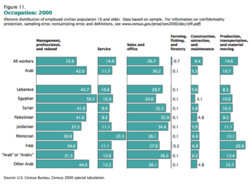
Source: United States Census 2000 [8]
Arabs have settled well in America. Statistics reveal that approximately eighty percent of Arab Americans hold at least a high school diploma, and 36 percent have a college degree. By attaining an education Arab Americans have set them self up for success in ore degree or another. Approximately 65 percent of Arab American adults are currently employed in the American labor force, and nearly 6 percent are unemployed. [7] Though Arab Americans work in all occupations, they are mostly found in more professional atmospheres.
Almost 70 percent of the working Arab American adults are employed in managerial, professional, technical, sales or administrative fields. Arabs have shown to be quite successful in there respective fields. Compared to the national average, the average Arab American family household income is 22 percent higher. This figures alone show us that the Arab community of America has been partially successful in its attempts at assimilating to the American social climate.
References
1. ^ United States Census 2000, . The Arab Population/Ancestry 2000. U.S. Government, 01/04/2001. Web. 1 May 2010.
2. ^ United States Census 2000, . The Arab Population 2000. U.S. Government, 01/04/2001. Web. 1 May 2010.
3. ^ Arab American Institute, . "Arab American Demographics." 01 March 2001: n. pag. Web. 2 May 2010. <http://www.aaiusa.org/arab-americans/22/demographics>
4. ^ Wikipedia, . "Arab People." 21 March 2009: n. pag. Web. 2 May 2010. <http://en.wikipedia.org/wiki/Arab_people>.
5. ^ United States Census 2000, . The Arab Population/Ancestry 2000. U.S. Government, 01/04/2001. Web. 1 May 2010.
6. ^ Alwan for the Arts, . "Book Reading and Discussion: How Does It Feel To Be A Problem by Moustafa Bayoumi." 10 September 2008: n. pag. Web. 2 May 2010. <http://www.alwanforthearts.org/event/258>
7. ^ United States Census 2000, . The Arab Population 2000. U.S. Government, 01/04/2001. Web. 1 May 2010.
8. ^ United States Census 2000, . The Arab Population 2000. U.S. Government, 01/04/2001. Web. 1 May 2010.
9. ^ United States Census 2000, . The Arab Population 2000. U.S. Government, 01/04/2001. Web. 1 May 2010.
Related Wiki Pages
Home Page
Reasons for Arab Immigration
Effects of 9/11 on Arab American Assimilation
Effects of the Economy on Arab Immigration
